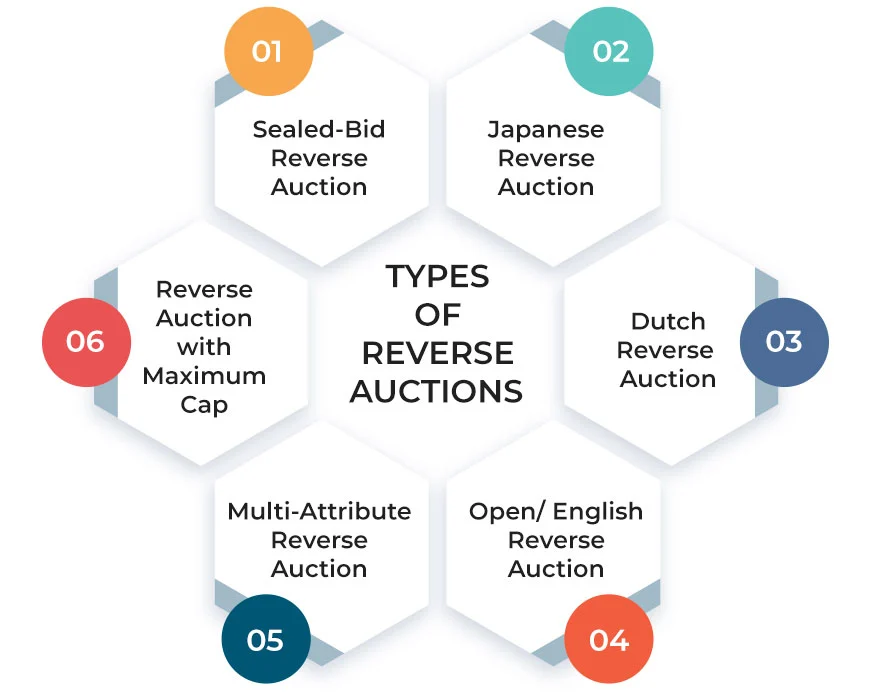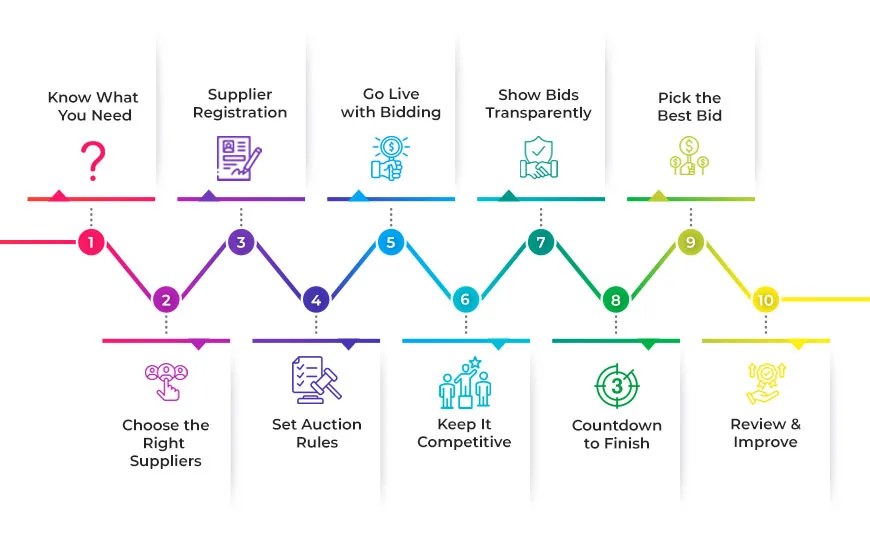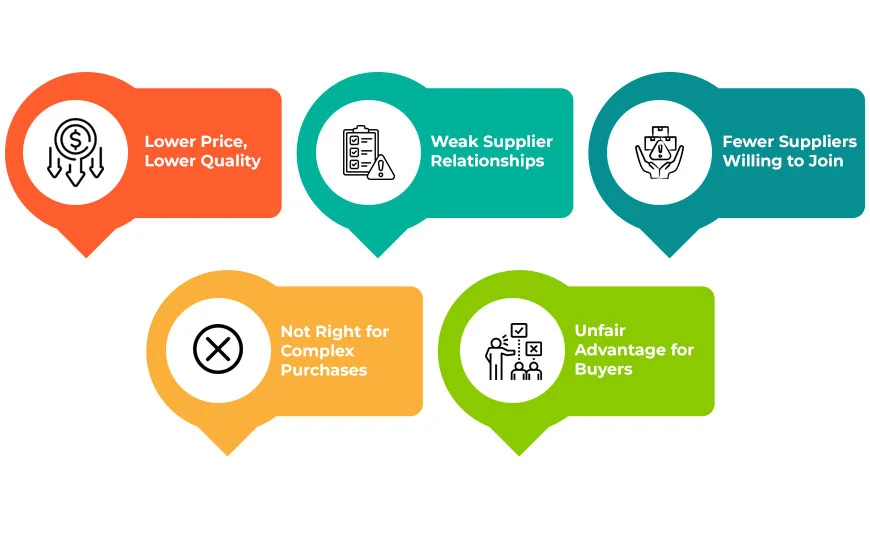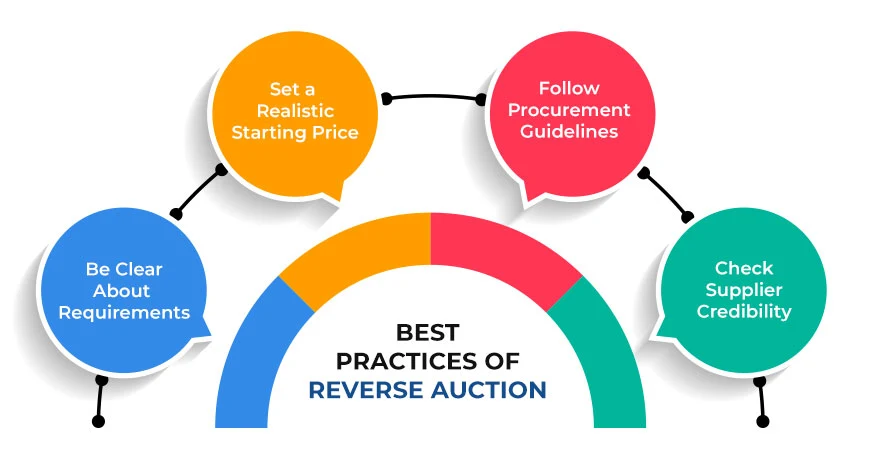What Is a Reverse Auction? How It Works, Example, and Risks
You must have heard about the auction, but the reverse auction took place in 1990. It is a bold idea, and it rapidly became a smart way to save money on purchasing.
Big companies like General Electric first used them in the late 1990s, saving nearly 20% on a $1 billion contract. Since then, many governments and businesses have followed the trend. India’s Government e-Marketplace has done deals worth over ₹4.5 lakh crore, saving around 9–15% on average.
In this blog post, you will understand the utility of reverse auction and how to apply it.
Let’s get started.
What Is a Reverse Auction?
A reverse auction is the opposite to a formal auction. Buyers tell their needs and requirements to sellers, and they compete to offer the minimal price to win a deal from a single buyer. This ultimately helps the buyers to save money while getting the quality and fulfillment of requirements without the tension of negotiation.
Meaning Of Reverse Auction
A reverse auction means that in a traditional auction, buyers bid for getting material at the lowest price, but in a reverse auction, sellers bid for selling the product or service and lower prices. Buyers share their needs, and sellers compete in the market by offering their prices. The vendor with the lowest bid wins the contract.
Online platforms play major roles here, as digital platforms become more transparent, fast, and easy to manage.
Reverse Auction vs Traditional Auction
| Element | Reverse Auction | Traditional Auction |
| Aim | Get the best value at the lowest possible cost. | Secure the highest price while maximizing profit. |
| Who Competes | Suppliers compete to offer the lowest price | Buyers bid against each other |
| Price Movement | Bids rise with each new offer | Prices go down as suppliers try to offer better deals than one another. |
| Type of Competition | Among vendors for a buyer’s contract | Among buyers for a product or service |
| Best Fit For | Common, repeatable products or services | Rare, collectible, or high-value assets |
| Winning Criteria | Lowest bid secures the deal | Highest bid secures the item |
Types of Reverse Auctions

Let’s know the types of Reverse Auctions are as follows:
- Sealed-Bid Reverse Auction
Everyone submits one secret bid at the same time, without knowing what others offered. The highest bid wins if buyers are competing, or the lowest bid wins if sellers are competing. It’s often used in government contracts or big business deals where fairness and privacy matter. - Japanese Reverse Auction
In a Japanese reverse auction, the process starts with the buyer setting an initial price. Suppliers join if acceptable, and the buyer lowers the price in stages. Suppliers can accept or reject each offer. The process continues until one supplier remains, encouraging competitive pricing while giving suppliers control over their participation in each round. - Dutch reverse auction
In a Dutch reverse auction, the buyer clearly defines the expected price, quality, and quantity upfront. Suppliers who meet these criteria submit their offers. This method streamlines procurement and encourages competitive bidding. It’s commonly used for raw materials, food items, IT services, and medical supplies, ensuring value for both parties. - Open/ English Reverse Auction
An English auction is a common type where people take turns offering higher prices for an item. The bidding lasts until no one is willing to go higher. The person with the highest bid wins. It’s often used to sell things like art, wine, antiques, and rare collectibles. - Multi-Attribute Reverse Auction
Multi-attribute is an approach where companies use cloud services from more than one provider, rather than depending on a single one. This approach offers more flexibility, reduces the risk of downtime, and helps avoid being locked into a single vendor. It also allows companies to choose the best tools from each provider. - Reverse Auction with Maximum Cap
In a reverse auction with maximum capacity bidders submit their best price in private. The highest bidder wins but pays only the second-highest bid plus a small increment. This encourages honest bidding without strategy games. The system is fair because it calculates results automatically and keeps them private to build trust.
How a Reverse Auction Works

There we are discussing how reverse auction works:
- Know What You Need
Start by clearly defining what you’re buying, add details like quantity, quality, delivery deadlines, and any specific standards. A clear description helps attract the right suppliers. - Choose the Right Suppliers
Invite reliable suppliers who meet your requirements. Vendors who is trustable in the auction can increase the chances of good results. - Supplier Registration
Suppliers sign up on the auction platform. They might need to share certificates or past work to prove they can meet your needs. - Set Auction Rules
Decide on key details: when the auction starts and ends, how much the bids should decrease, and whether other suppliers can see each other’s bids. - Go Live with Bidding
Suppliers log in and start bidding. It is not like traditional bidding; prices go down here; vendors compete by providing lower prices. - Keep It Competitive
As the auction progresses, suppliers watch each other’s bids and adjust their own to stay competitive, helping you get the best price. - Show Bids Transparently
Most platforms show current bids (often anonymously). This keeps suppliers engaged and encourages better offers. - Countdown to Finish
Auctions usually have a visible countdown timer. Suppliers must place their final bids before time runs out. - Pick the Best Bid
After the auction, the supplier with the lowest bid who also meets all the requirements is awarded the contract. - 10. Review & Improve
After it’s over, you can look back at how the auction went and use those insights to plan future auctions more effectively.
Use cases of Reverse Auction
Reverse auctions have changed the way companies buy goods and services. What began as a small idea is now a popular way for businesses to save money and get better deals, especially in industries where cost and speed are important.
- In manufacturing, companies use reverse auctions to secure raw materials and machinery, helping them stay ahead and competitive.
- Construction firms bid out labor, materials, and equipment rentals, often helping businesses spend less and make better choices.
- Logistics and transport providers enter reverse auctions to win freight contracts, keeping delivery chains moving without overspending.
- In the IT world, they’re a clever way to source everything from cloud services to cybersecurity tools, without compromising on quality.
- Hospitals and healthcare networks use them to get the best deals on medical gear and pharmaceuticals, all while ensuring patient care stays uncompromised.
- Energy companies leverage reverse auctions to lower costs on infrastructure, repairs, and fuel sourcing, especially in volatile markets.
- Retailers push vendors to sharpen their pencils through reverse bidding for product supply, packaging, and store needs.
- Financial institutions tap into this model for tech services, risk tools, and outsourcing needs.
Benefits of Reverse Auction
Reverse auctions are a smart and dynamic tool for procurement teams aiming to cut costs and secure better deals from suppliers. Here’s how they create real value:
- Big Savings on Costs: Reverse auctions encourage suppliers to compete by offering their most competitive prices. This often results in significantly lower costs compared to traditional procurement methods.
- Faster, Smoother Negotiations: Instead of lengthy one-on-one negotiations, reverse auctions display real-time bids from multiple suppliers. This allows you to identify the best offer quickly and close deals much faster.
- Easier Budgeting and Planning: With clear, upfront pricing from auction outcomes, procurement teams can forecast expenses more accurately and manage budgets more effectively.
- Fair and Transparent Process: All suppliers receive the same information simultaneously, creating a level playing field. This transparency fosters fairness and reduces bias in decision-making.
- Better Market Insights: Reverse auctions offer valuable data on supplier pricing and market trends. This helps buyers make informed decisions and build stronger supplier partnerships.
- Real-Time Flexibility: As market conditions change, procurement professionals can adjust strategies and respond instantly during the auctions, something traditional methods can’t offer as easily.
- Supports Strategic Sourcing Goals: Reverse auctions align well with strategic sourcing by streamlining supplier selection and negotiation. They help organizations meet their purchasing goals efficiently without compromising on quality.
Challenges and Limitations

- Lower Price, Lower Quality
Choosing the lowest bid may save money upfront, but it often results in lower quality. Sometimes, spending a little more delivers better long-term value. - Weak Supplier Relationships
When suppliers are forced to lower prices too much, it can hurt their profit and reduce trust. This may affect long-term partnerships. - Fewer Suppliers Willing to Join
Some vendors avoid reverse auctions because they feel it’s all about price, not fairness or quality. This reduces your supplier’s options. - Not Right for Complex Purchases
Reverse auctions work best for simple, standard products. For customs or complex needs, this method might not give the best results. - Unfair Advantage for Buyers
Buyers see all the bids, but suppliers don’t know what others are offering. This can feel one-sided and reduce supplier trust.
Trends of Reverse Auction
Reverse auctions are evolving rapidly, driven by AI, data analytics, and modern digital tools. At Beyond Intranet, we help procurement teams embrace this transformation to reduce costs, accelerate decision-making, and drive better results.
- Smarter Bidding with AI
This intelligent auction engine uses predictive analytics to suggest the most effective bid amounts and timing helps you secure and optimal pricing.
- Better Supplier Selection
Leverage AI to evaluate supplier performance and reliability patterns, ensuring you choose partners that deliver consistent value.
- Actionable Data Insights
With real-time analytics, you gain visibility into pricing trends, supplier behavior, and market shifts which enables more strategic procurement decisions.
- Increased Efficiency through Automation
Automate key tasks such as bid scoring, supplier evaluation, and purchase order workflows that saves time, reducing errors, and improving compliance.
- Intuitive Auction Platforms
Beyond Intranet offers user-friendly interfaces with live bidding dashboards, smart filters, and automated reporting makes auction management simple and effective.
- Cloud-Based Flexibility
Access your auctions anytime, anywhere. These cloud-based tools enable seamless collaboration, real-time updates, and full visibility from requisition to payment.
Best Practices of Reverse Auction

- Be Clear About Requirements
Clearly outline what you need, specifications, quality standards, and delivery expectations, before starting the auction. - Set a Realistic Starting Price
Make sure your base price is attractive enough to draw bids but still reflects fair value and quality. - Follow Procurement Guidelines
Ensure all auction steps align with your organization’s rules and government procurement policies. - Check Supplier Credibility
Always verify the background and reliability of the winning bidder before awarding the contract.
Tools and Platform for Reverse Auction
- Beyond Intranet
Beyond Intranet offers the best custom reverse auction platform that fits perfectly with your company’s needs. It is built on Microsoft 365, making it easy for businesses already using those tools.
You can set your own auction rules, track bids in real time, and view detailed reports. It’s ideal for companies that want to save money without compromising on quality, especially in industries like healthcare, retail, and construction. - SAP Ariba
SAP Ariba is a well-known tool used by large companies. It helps manage auctions and supplier bids and works best for those already using SAP systems. - Coupa
Coupa is a user-friendly platform that helps businesses run auctions and manage spending. It’s great for tracking bid activity and saving costs. - GEP SMART
GEP SMART offers reverse auction features along with other procurement tools. It supports global suppliers and is a good choice for large industries like energy and manufacturing. - Market Dojo
Market Dojo is an easy and affordable option, especially for smaller businesses. You can run auctions quickly and only pay when you use them.
Bottom Line
Reverse auctions are redefining procurement cost saving, faster sourcing, and complete transparency. At Beyond Intranet, we help organizations embrace this competitive, data-driven approach to make better buying decisions and strengthen supplier relationships. Ready to transform your procurement process? Let’s get started.






